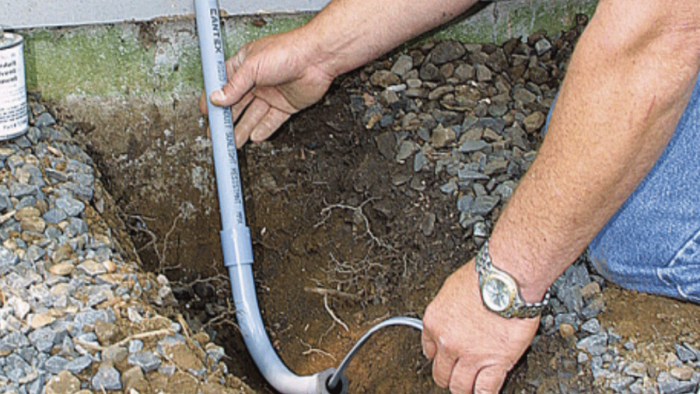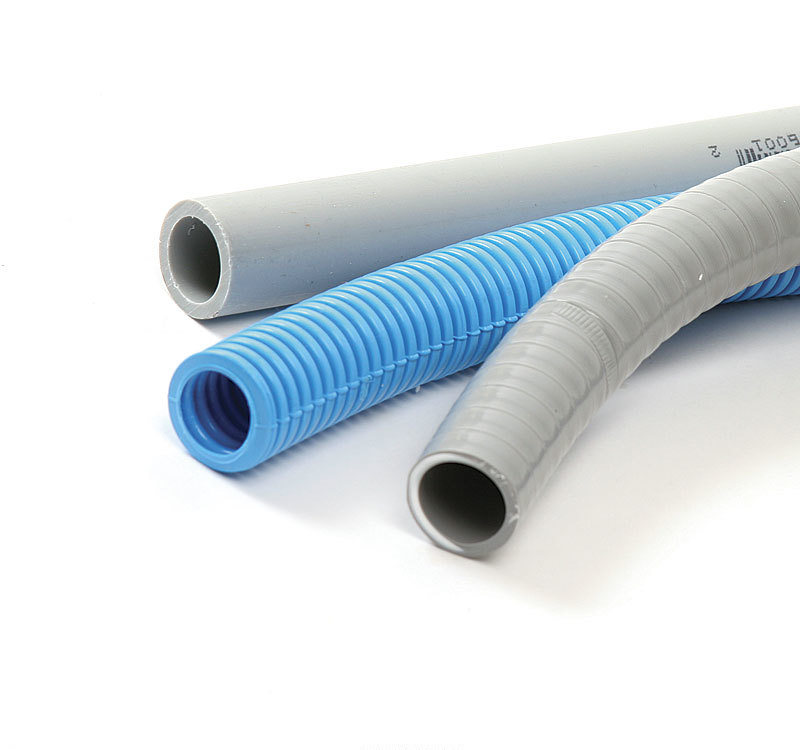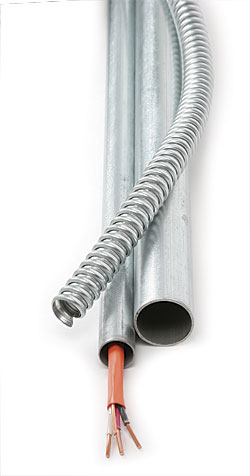Electrical Conduits
With several varieties of conduit available at most home centers and supply houses, it’s essential to know the merits of each and what you can and cannot do with it.

Plastic and metal
Electrical conduit is needed in certain locations to protect wiring from damage that can occur from drywall screws, abrasion, or UV rays, which degrade insulation when wires are run outside.
With several varieties of conduit available at most home centers and supply houses, it’s essential to know the merits of each and what you can and cannot do with it. As with any electrical work, the best source of information about what to use is the latest edition of the National Electrical Code(NEC), and it’s always a good idea to call your local building department to see what code(s) it enforces. There are two different categories of conduit for electrical installations: plastic and metal. Each has its place in the residential environment, and some jurisdictions require one type over another for a particular application.
Plastic Conduits

Rigid PVC pipe, electrical nonmetallic tubing (ENT), and liquid-tight flexible nonmetallic conduit (LFNC) are the most likely plastic conduits to be found in a residential setting.
Because it’s approved for direct burial and—if it’s a schedule-80 pipe—can be used to meet the NEC’s requirement for “protection from physical damage,” rigid PVC is run in most new underground service entrances to the electricalmeter enclosure. Sizes range from ½ in. dia. to 3 in. dia. for common residential applications. Rigid PVC is inexpensive; can be worked easily without expensive tools; and can be used in walls, outside in the sun, and underground. Connections are made with PVC glue. Rigid PVC can become brittle in cold weather, so check manufacturers’ acceptable temperature ranges.
Most homes in my area have at least one 6-ft.-long “whip” of LFNC attached to the exterior air-conditioning unit. The major advantages of LFNC are that it’s flexible, waterproof, and resistant to UV rays, making it safe to use outdoors. Because it’s made of PVC, it can be cut easily. (I use a PEX-tubing cutter for this.) A few drawbacks limit its use: It tends to cost over twice as much per foot as rigid PVC, the cost of its associated liquid tight fittings is relatively high, and it cannot be used where it would be subject to physical damage. However, it is easily the best choice for numerous applications for exterior work—such as with equipment near swimming pools and hot tubs—and its flexibility often makes it the only suitable conduit for a particular application.
ENT, or “Smurf tube” (nicknamed because of its light-blue color), is a corrugated, flexible PVC plastic tubing used mostly for dry interior work or in certain places, such as a basement or crawlspace, where moisture exists on the interior of a building. ENT is easier to install than rigid PVC, although it and its fittings are about twice the price. However, not all jurisdictions allow for residential wiring with ENT, and there are some places in a house where it cannot be installed—for example, it can’t be used for exposed work, and with a few exceptions, it needs to be protected from physical damage. However, it can be encased in concrete and within slabs when the appropriate fittings are used, making it a viable choice for roughing in kitchen islands on a slab.
Metal Conduits

Most metal conduits are made of galvanized steel, but some types also can be found in aluminum. The most common steel conduits seen in a residential application, and the ones most commonly available from local home centers, are rigid metal conduit (RMC), electrical metallic tubing (EMT), flexible metal conduit (FMC), and intermediate metal conduit (IMC).
RMC is the thickest, stiffest, and heaviest of the four and requires special tooling to bend and thread. Most homes in my area have only one run of RMC, if any, and it’s used for the service-entrance mast that attaches to the electric-meter base. Given the amount of tension on the mast from the overhead service wiring, and the importance of protecting the serviceentrance conductors from damage, RMC is clearly the pipe of choice for this application. However, all other applications within a typical residence can be done with another type of metal or plastic conduit, so RMC’s further use is limited more to commercial and industrial settings. Most RMC is made of galvanized steel, but it is also available in aluminum.
FMC is a helically wound, flexible tubing most often made from aluminum. Because it cannot be used outside or in other wet locations, FMC is somewhat limited in its usefulness, but there are a few applications where it is the clear choice. For instance, most new direct-wire cooktops and ovens require a section of FMC for connection to a power source that can remain flexible during the actual installation of the appliance, and many furnaces and heat pumps are coupled to their disconnect with a short whip of FMC. For that reason, many newer ovens and cooktops come wired with FMC attached, and most home centers and supply houses stock at least 1⁄2-in.-dia. and 3⁄4-in.-dia. FMC and associated fittings. It can be cut with a hacksaw, but specialized cutting tools are available.
EMT is a thin-walled metal conduit most often found in galvanized steel, but it’s also available in aluminum. EMT is relatively inexpensive; can serve as protection from physical damage; and can easily be bent, cut, and installed with a minimal amount of special tools. EMT can be installed outdoors, provided all fittings, supports, and fasteners are made of corrosion-resistant materials. I often see EMT in older homes to protect the ground wire coming out of the meter base, but it can satisfy several other needs in residential construction and renovation. I have used EMT quite a bit as a means for protecting exposed wiring, such as on garage walls for new receptacles or light fixtures.
IMC (not pictured) is thinner than RMC, but thicker and far more rigid than EMT. It’s rarely used in my area, but some electricians may choose it over RMC for its lower cost and lighter weight. It’s code-approved for the same uses as RMC.
Size Matters
The last and sometimes most important consideration when choosing conduit is the size of pipe needed to run wiring safely. The size of each conductor (that is, each individual wire), the conductor configuration (stranded versus solid wire), and the type and temperature rating of the insulation on the wire itself (for example, THHN or XHW) determine how many conductors you can legally run through each pipe. There are a number of good reasons for playing by the rules here—most important, to avoid starting a fire. Running too many conductors through a length of conduit doesn’t leave enough free airspace to allow the wiring to stay within an acceptable temperature range. This can cause overheating and degradation of the insulation. Because of the number of variables involved, you must consult code books to determine the appropriate sizing for your conduit installation.
For More Information:
- Crash Course in Conduit
- Video Series: Electrical Retrofit With Surface-Mounted Conduit
- Clearing a Submerged Conduit
From Fine Homebuilding #240





